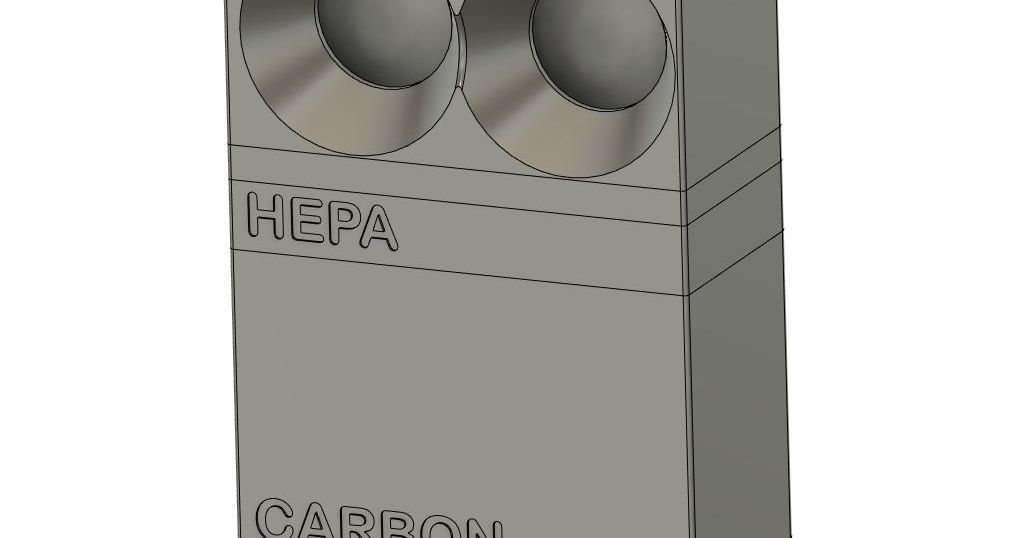Wireless powered Bento Box Air Purifier for X1C / P1P
Wireless powered Bento Box Air Purifier for X1C / P1P
Print Profile(1)

Description
The content is too long and has been truncated
UPDATES:
- April 7th: Added support for 24V 4020 fans on V2 design (should also work for V1 designs). If using 24V fans, trim the boost converter output to 24.0 instead of 12.0
- April 7th: Added “wireless test jig” to help with assembled coil testing before installing the enclosure. Simply mount the transmitter box into the allotted space and align the receiver box on the debossed corner. The receiver coil should be over the non-perforated region of the base.
WIRELESS POWER:
The major change here is that I added an wireless receiver module to the bottom of the assembly coupled with a wireless transmitter module for installation under the unit. Alignment between the receiver and transmitter was determined via a 3D scan of the X1C and should be as close to perfect as you can get in X, Y, and Z (z-distance matters as much as X and Y).
Everything is magnet or friction fit installable and requires no modification to the printer housing. Power is supplied via an external micro-USB port and the instructions provide parts for a completely solder-free assembly.
V2 BENTO BOX
Printed Parts

Fan Duct 6x3 magnets or Fan Duct 4x2 magnets
Receiver Box 6x3 magnets or Receiver Box 4x2 magnets
Wireless Transmitter Box
Wireless Transmitter Cover
(OPTIONAL) Wireless Test Jig
(From Bento Box Creator)
Cover_voronoi or Cover_hemp
Hepa
Carbon
Fan case
CMag Case 01
CMag Case 02
4x net_infill
BentoBox20 User Guide
Materials

12V 4020 Fans or 24V 4020 Fans
Wireless Receiver
Wireless Transmitter
Booster Converter 3-35V with LED Voltmeter (alternate: source 1, source 2)
Wire Connector (for solder-free option)
USB Charger (minimum 2A)
Flat micro-USB to USB A cable
6mmx3mm disc magnets or 4mmx2mm disc magnets (depending on version)
Hepa Filter
Activated Carbon Pellets and alternative vendor (MUST BE ACID-FREE)
Brass inserts (M3xOD5mmxL4mm)
INSTRUCTIONS:
- Assemble Wireless Receiver

1) Use the wire crimper, or a soldering iron, to connect the receiver
1) Following V1 instructions as reference, install the receiver coil into the V2 receiver box
- Assemble wireless transmitter

1) Install the wireless transmitter into the transmitter box by carefully laying the coil (coil side down) into the box.
Note: This is definitely the most sensitive step in the installation. The ferrite disc is extremely brittle and can easily crack from point forces. If the disc breaks, the transmitter will likely drop enough in efficiency that it will no longer transfer enough power to run the fans. Because of part-to-part variation, you may need to fiddle a bit to get the coil to sit properly in the housing. It is critical that the coil lay flat in the housing.
2) Slot the transmitter PCB into its port and push it down onto the retaining clip.
Note: Because of part-to-part variation, you may need to fiddle a bit to get the PCB to sit properly in the housing. Pull back on the retaining clip, but be careful not to snap it.
- Trim power converter

1) The boost converter linked has a variable output and needs to be trimmed to 12V (for 12 fans) or 24V (for 24V fans) before assembling. Do this by powering the assembled wireless transmitter and centering the assembled wireless receiver on top of it.
2) Use the wireless test jig to align the coils
3) If the coils are properly aligned, the display should illuminate. You may need to press the IN button to turn on the display.
4) If the display reads 5V, press the OUT button to change the output to the converted voltage.
5) Turn the potentiometer near the power led until the LED displays 12V or 24V (depending on fans chosen). If the display does not change value, press the out button and try again.
- Install boost converter into receiver box

1) After cutting the ends off the fan wires (be careful not to cut the wire too short, extra slack is better than not enough), mount the boost converter onto the standoffs in the receiver box
- Align fan duct onto receiver box

1) Place the fun duct on top of the receiver box and align the boost heat sink and display into the fan duct holes.
- Assemble and install Bento Box

1) Assembly the individual modules, magnets, add carbon pellets, and hepa filter into their respective boxes.
2) Gain access to the underside of the X1C
3) Install the transmitter box in the space provided. Make sure you push it flush against the underside plastic.
4) Route the micro-USB out the back of the system.
- Install Bento Box


If all went well, the Bento Box should power up once it is placed in the system
Comment & Rating (27)
































